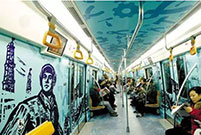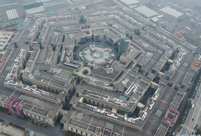

For people around the world, dining out follows a similar pattern: Arrive, queue, wait to order, eat and then pay. One Chinese restaurant, however, has ripped up the rule book, and in doing so might just change the way people eat out forever.
While many restaurants go to great lengths to create a certain ambience or plate up food so that it looks more like art than a meal, noodle restaurant Renrenxiang, in Beijing's downtown Guomao, has made a name for itself by doing something all-together different.
The first thing customers notice when they arrive at the noodle restaurant is that there is something missing. While it is customary that waiters greet customers at the door and show them to a table, there is no one to do this at Renrenxiang. In fact, there are no waitstaff at all.
In place of hosts, waiters and cashiers, there is something a lot more 21st century -- a phone app. The only place with human activity is the kitchen where chefs turn digital orders into dishes.
The restaurant's app runs on WeChat, China's most popular online messaging app.
Diners order and pay with the app, wait for their number to be called and then take their own food from the counter. After eating, they deposit their crockery on a cleaning table.
Moreover, customers don't even have to be in the restaurant to order. One frequent diner, Miss Wang, who works nearby, says she orders while still in the office and takes a leisurely stroll down to the restaurant. By the time she arrives, her food is ready and she can enjoy it immediately. "It's very convenient," she says.
Liu Zheng, CEO of Renrenxiang, is proud and optimistic about this system as it reflects the popular online-to-offline service trend gripping China currently. It makes his business more efficient and saves him money as he has less wages to fork out for.
"Opening a restaurant has a huge outlay: Rent, decoration, salaries, the list goes on. Thanks to the rise of the app we can cut out unnecessary expenditure, simplify management and focus more on taste and quality," Liu says.
The app also collects customer-related data -- what dish is the most poplar, and what age groups visit more frequently. Renrenxiang uses the data to improve its marketing strategy.
Liu says he plans to further automate the process to achieve the "Four No's" -- no waitstaff, no cashier, no purchaser and no chef.
Renrenxiang is not the first restaurant to offer waiterless service. As early as in 2007, a restaurant in Nuremberg, Germany, began to offer fully automated order and table services. There are also places in Japan and the United States.
Though a waiterless restaurant is still a novelty, automation is already part of many restaurants. More and more now allow customers to make reservations online, order through touch-screens and pay by mobile payment services.
Using robots, instead of humans, to cook, serve and clean has also become more common in China this year.
But will these developments lead to a waiterless future?
No one can deny the change that technology has had on people's lives, and it was only really a matter of time before automation really took off in the restaurant industry.
"The catering industry involves lots of human activity but that doesn't mean restaurants must have waitstaff. The core of the industry is service and most of this can actually be done by machines and programmed systems. Reducing the roles of waiters and cashiers is not the same as reducing the standard of service, instead it means quicker service and reduced costs," says Jiang Xiaoyu, an employee at Renrenxiang.
There are, however, those who are loath to lose the "traditional" style of dining and are steadfast in their belief that it cannot be replaced.
"Waiterless service works well for fast food, as the food prep is standardized and it's relatively easy to make the switch to automation. In finer restaurants, however, the cooking process is complicated and the role of waiters is more than just serving food," says Wang Jianhao, the owner of Xiexilan, a Sri Lankan restaurant in Beijing's bustling Sanlitun area.
"The catering industry is very diverse -- just like the needs of many customers, so various types of service need to be available," Wang says.
"Dining at a restaurant isn't just about eating," says a new customer surnamed Zhang at Renrenxiang. "The overall ambiance, the joy of browsing the menu and selecting dishes, and the satisfaction of being well served are also important. Technology does make life a lot more convenient, but it can't replace human interaction."
 Have you ever taken these beautiful subways in China?
Have you ever taken these beautiful subways in China? Chinese beauties, foreign models meet in Chengdu
Chinese beauties, foreign models meet in Chengdu Awesome! Aerial pictures taken on J-11 fighter
Awesome! Aerial pictures taken on J-11 fighter A foreign girl explains what China should be proud of
A foreign girl explains what China should be proud of Chinese navy's air-cushioned landing craft in pictures
Chinese navy's air-cushioned landing craft in pictures Chinese pole dancing master opens class in Tianjin
Chinese pole dancing master opens class in Tianjin Splendid Sichuan after snow
Splendid Sichuan after snow College girl of Vancouver crowned Miss Chinese Int'l 2016
College girl of Vancouver crowned Miss Chinese Int'l 2016 Pentagonal Mart becomes the largest vacant building in Shanghai
Pentagonal Mart becomes the largest vacant building in Shanghai Top 20 hottest women in the world in 2014
Top 20 hottest women in the world in 2014 Top 10 hardest languages to learn
Top 10 hardest languages to learn 10 Chinese female stars with most beautiful faces
10 Chinese female stars with most beautiful faces China’s Top 10 Unique Bridges, Highways and Roads
China’s Top 10 Unique Bridges, Highways and Roads Hijacking the airwaves
Hijacking the airwaves Ma’s island visit draws line for DPP
Ma’s island visit draws line for DPP Private schools attempt to keep Tibetan language alive
Private schools attempt to keep Tibetan language alive Poor reviews spark debate about Lang Lang’s musical standing
Poor reviews spark debate about Lang Lang’s musical standingDay|Week